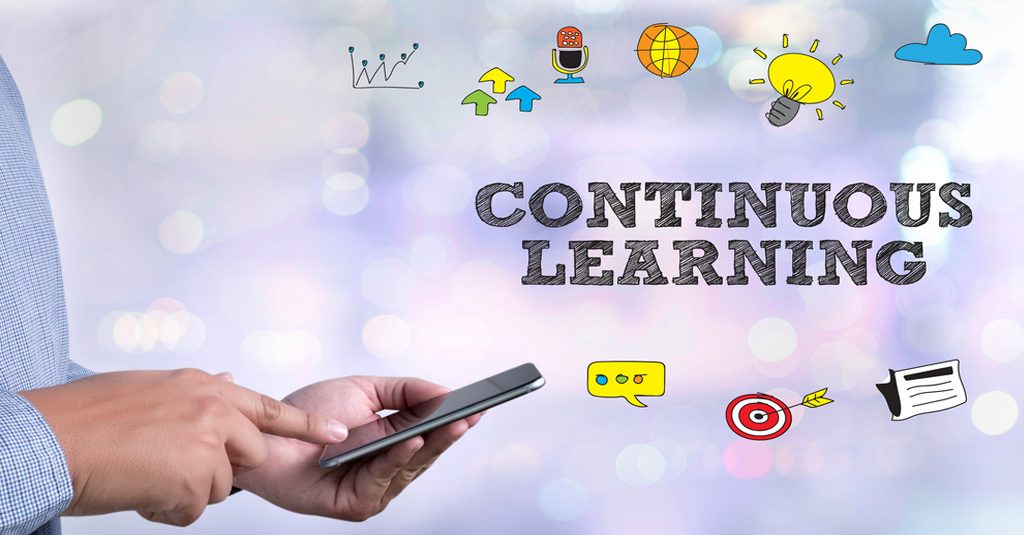With ever-evolving technological developments and innovations at workplace, businesses are becoming more efficient. Continuous learning at the workplace has been a popular buzz in today’s digital scenario. It helps the new-age workforce to boost their ability to learn by upgrading the desired skills and expertise. A swift change in demographics and the constant need to evolve has completely transformed the digital learning landscape. These changes are pushing organizations to create innovative ways, enabling learners to foster a continuous engaging learning experience throughout the organization.
Organizations that embrace a shift from customer-centric “push” approach to the learner-centric “pull” approach ensures to deliver more effective learning. Continuous learning adopts a pull approach to enable learners access e-courses per their convenience. With changing business needs, educators align the same courses again to re-engage employees. Learners can earn rewards and badges on completing a certain level, thereby motivating other employees to undergo an online training program. With continuous learning experiences, employees constantly learn, retain for long and work in collaboration to improve overall business growth. The training needs of new-age learners are dynamic, thereby making the learning curve continuous and engaging at the same time.
The availability of online courses across personalized mobile devices has also enabled the workforce to learn at their own pace. Learning is no more a one-time opportunity, it can be done at the point of need and from anywhere. Employees can choose any course, look for a short-duration interactive video or podcast to quickly learn any specific skill.
Continuous Learning as a Utility
When we were seeking for more ways to embrace new technology for continuous learning engagement, it came as a daunting challenge. When organizations prepare their workforce for continued learning engagement, they ask them for self-assessment. Through continuous learning, we ensured the delivery of an immersive experience for diversified audiences. Let us discuss one instance where we used learning as a utility. We created online courses for employees with 0-4 years of experience. Later, the client wished to access the same courses for more experienced employees. So, we incorporated HTML chatbots to cater to the customized needs of all. We designed a new package comprising of the desired-learning modules in the form of video nuggets and presentations which could be accessed by all. To create a continuous learning environment, different kinds of mediums are created to ensure delivery of a highly engaging experience:
Pull, Not Push Learning Approach
In today’s digital era, modern learners want to pull information on their own and at their own pace, instead of being pushed from the other side. Pull learning is a bottom-up approach where learners access training at the point of need. It helps to boost collaboration between learners and educators, by making the best use of e-learning technologies. For instance, sales personnel are trained in a way that they can effectively pull in potential customers by adding more value. We also encourage 360 degrees review to allow learners fill surveys and give instant feedbacks, so that courses can be updated to cater to different job role needs and revive training.
Incorporate badges & formal certificates
Incorporating badges and certificates in e-learning courses help to recognize learners’ achievements at preliminary level. These lead to increased learner participation and workplace performances. The reward system is an effective gamification strategy, providing learners with an opportunity to highlight their experience and continually improve their knowledge.
Discovery approach
Instead of adopting an expository approach where courses depict concepts followed by examples, we prefer the discovery approach where we present a series of questions, challenges and scenarios to develop a strong knowledge competence. Learners are guided to unearth new information. The benefits of adopting discovery approach are that it promotes active learning by:
- Promoting independent thinking
- Developing course relevance for the learner
- Facilitating the construction of knowledge
Leaders video & video-based learning
Presently, one of the optimum ways to convey a powerful message from the leaders is by embedding videos in e-learning courses. Videos delivered through mobile devices (smartphones and tablets) enable learners to pace the content as per their needs. These provide an immersive learning environment for the users, which increases their engagement level and leads to improved employee retention.
Adaptive learning
Workplace training is at the heart of change and adaptive learning is one of the key factors that is driving the scope of digital learning. Adaptive learning is an optimum way to visualize the training process, seek lucrative outcomes while controlling costs. It ensures delivery of personalized learning experiences, making continual adjustments to learning paths based on individual performances.
In a nutshell, workplace culture for continuous learning fosters strong motivation, boosts learner engagement & retention and improves business growth. Continuous learning aids new-age learners to perform effectively and adapt to the latest changes at the workplace. It serves the benefits of adopting a flexible approach and producing long-term outcomes from an online training program. Continuous learning implies facilitating workforce’s active searches to improve skills and understanding how to adapt new abilities into work processes. In simple terms, it helps organizations anticipate, react to and embrace changes in today’s dynamic workplace learning culture.








